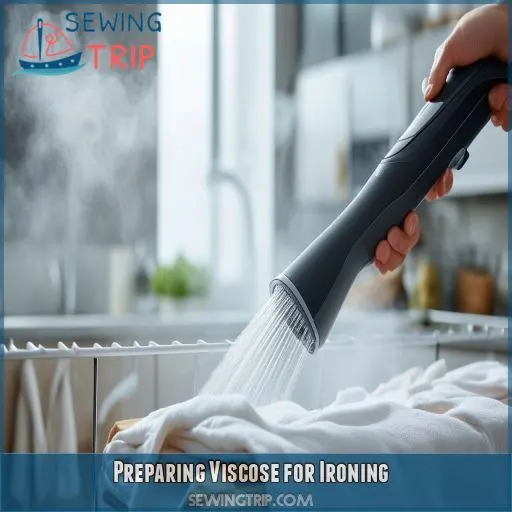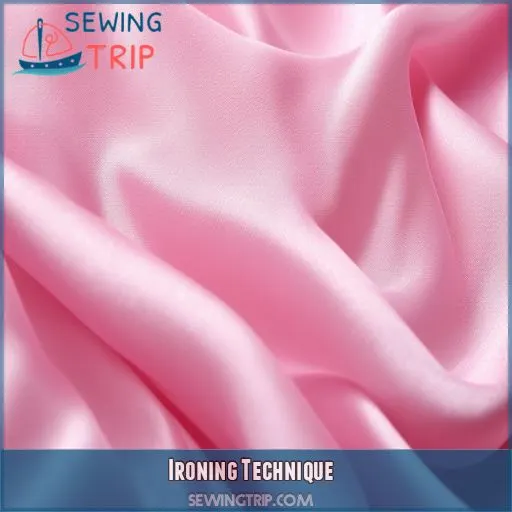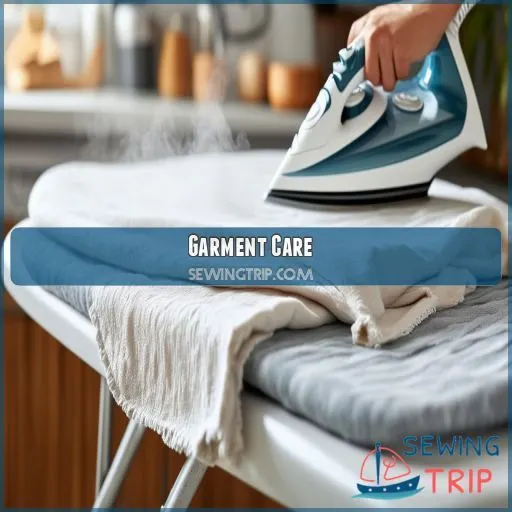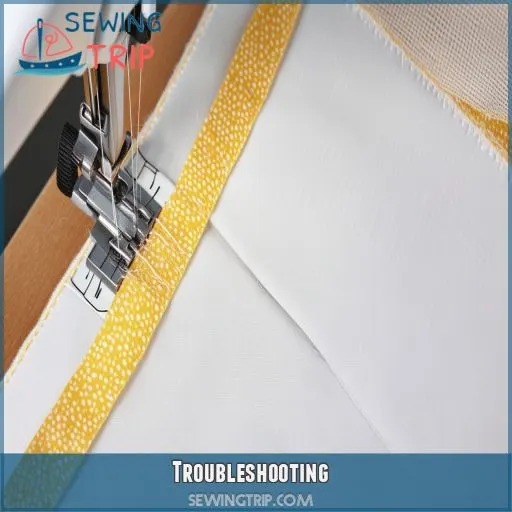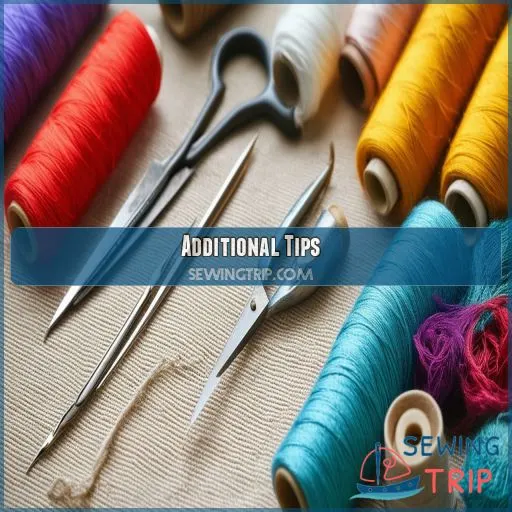This site is supported by our readers. We may earn a commission, at no cost to you, if you purchase through links.

For ironing, set your iron to the "Rayon" or "Silk" setting and turn off the steam. Lightly dampen the garment before ironing. Use a press cloth, keep the iron moving, and apply gentle pressure to avoid stretching the fabric.
Work in sections and always press from the center outwards. Hang the garment on a wooden hanger to maintain its shape.
If you follow these steps, your viscose will stay smooth and shrink-free. Stick around for more tips on perfect garment care!
Table Of Contents
Key Takeaways
- Ironing viscose is like handling a slippery fish – it requires gentle care to avoid stretching.
- To prevent shrinkage, wash viscose by hand in cold water, using a mild detergent, and air-drying it flat.
- When ironing, use a low heat setting, keep the iron moving, and employ a press cloth to avoid damage.
- Hang viscose garments on wooden hangers to maintain their shape, and store them in a cool, dry place to prevent fading.
How to Iron Viscose Without Shrinking It?
To iron viscose without shrinking it, use a low-temperature setting and make sure the fabric is slightly damp. Avoid pressing too hard and iron sections slowly to prevent damage.
Preparing Viscose for Ironing
Start by washing your viscose garment with cold water and a gentle detergent, avoiding excessive rubbing or twisting. After washing, dampen the fabric lightly with water to prepare it for ironing.
Washing
Washing viscose requires careful attention to preserve the fabric’s delicate nature. hand wash the garment in cold water with a mild detergent to prevent damage. Machine wash risks should be minimized; if you must use a machine, place the garment in a wash bag and select a delicate cycle. Avoid excessive rubbing or twisting to maintain the fabric’s integrity. After washing, air dry the garment flat or on a hanger.
- Hand wash in cold water
- Use a mild detergent
- Opt for delicate cycle in a wash bag if machine washing
- Air dry flat or on a hanger
Dampening
After washing, dampen the viscose lightly to prepare for ironing. This step helps prevent damage and makes the fabric easier to handle. Follow these steps for the best results:
- Use a spray bottle with cool water to lightly mist the fabric. Avoid over-dampening and heavy spray.
- Confirm the ironing board is stable and clean to avoid transferring stains.
- Mist the fabric on both sides if it feels too dry while ironing.
- Keep the fabric soft and manageable, allowing natural air drying after ironing.
This ensures fabric protection and effective ironing without shrinking the delicate rayon.
Ironing Technique
To iron viscose without shrinking it, start by using a low heat setting and always keep the iron moving to avoid damage. Press gently and work in small sections, ensuring the fabric doesn’t stretch or shine.
Temperature Setting
When ironing viscose, precision is key due to its fabric sensitivity:
- Temperature Control: Set the iron to "rayon" or "silk" to prevent heat damage.
- Iron Pressure: Apply light pressure to avoid stretching.
- Steam Avoidance: Turn off the steam setting to protect the silk-like touch.
- Dampening: Lightly spray water on the fabric for smooth ironing.
Pressing
When pressing viscose, follow these steps to protect the fabric and maintain its shape:
- Move the iron continuously to avoid distortion and prevent shrinkage.
- Apply gentle pressure rather than forceful pressing.
- Iron inside-out with a damp cloth to avoid shine.
- Keep the temperature low, using the "Silk" setting to protect the delicate fabric.
Sections
To iron viscose effectively, work in sections. This prevents stretching and guarantees an even finish:
- Use a press cloth to protect the fabric.
- Keep the iron moving to avoid heat damage.
- Press gently; too much pressure can stretch the fabric.
- Ensure fabric dampness for smooth results, but avoid steam settings.
Work from the center outwards for best results.
Garment Care
Proper garment care is essential to maintain the quality of your viscose. Always hang your garment on a wooden hanger and store it in a sealed plastic tub in a cool place to avoid damage.
Hanging
After ironing, it’s essential to hang your viscose garments appropriately to preserve their form. Utilize wooden hangers, as they offer support without warping the fabric. Make certain your clothes are completely dry prior to hanging.
- Hang in a cool, well-aired area.
- Store separately to prevent overcrowding.
- Gently clip lightweight items to maintain structure.
- Refer to garment labels for hanging instructions.
Storage
Store your viscose garments in a cool, dry place to keep them looking fresh. Here’s how:
- Folding Techniques: Use acid-free tissue paper to prevent creasing.
- Stain Removal: Make sure the garment is clean before storage to avoid set-in stains.
- Odor Elimination: Use lavender sachets to keep garments smelling lovely.
Following these steps guarantees your viscose stays pristine.
Avoiding Damage
To avoid damaging your viscose garments, steer clear of bleach and harsh chemicals, as the fabric is highly sensitive. Remember to never expose viscose to direct sunlight, which can cause fading and degradation. To prevent fabric distortion and pilling, follow these steps:
- Choose natural drying methods.
- Use a wash bag in the machine.
- Handle gently to maintain shape.
Troubleshooting
To prevent shine, always iron viscose inside out and use a press cloth when necessary. Avoid stretching by ironing in small sections and keeping the iron moving to prevent heat buildup.
Shine
Sometimes viscose can develop an unwanted shine after ironing. To tackle this, follow these steps:
- Shine Removal: Lightly spray the shiny area with water. This helps in removing the shine by reworking the fibers.
- Press Cloth Protection: Place a press cloth over the damp area. This protects the fabric from direct heat.
- Ironing Temperature: Set your iron to the "Silk" or "low" setting. Keep it low to avoid damaging the fabric.
- Fabric Protection: Gently iron the area again, keeping the press cloth between the iron and the fabric.
These steps guarantee a smooth finish.
Stretching
Viscose can easily stretch if not handled properly. To avoid this, follow these tips:
- Iron gently: Press lightly and keep the iron moving to prevent stretching.
- Small sections: Tackle areas bit by bit, ensuring even pressure.
- Correct setting: Use the "silk" or "low" setting to avoid fabric shrinkage.
- Use press cloth: This adds a layer of protection, reducing distortions.
- Cool before moving: Let the garment cool completely to preserve its shape.
Additional Tips
To guarantee your viscose garments remain in pristine condition, remember these additional tips:
- Fabric softness: Utilize a gentle fabric softener in the final rinse to maintain softness.
- Drying methods: Choose air drying flat on a hanger instead of machine drying to prevent shrinking.
- Garment preservation: Maintain your wardrobe’s freshness with lavender sachets and address stains promptly to preserve the fabric.
Frequently Asked Questions (FAQs)
How to prevent viscose from shrinking?
To prevent viscose from shrinking, use cold water and mild detergent for hand washing. Air dry flat on a hanger, and when ironing, turn the garment inside out and use a low setting with a pressing cloth.
Can 100% viscose be ironed?
Yes, you can iron 100% viscose fabric by carefully using low heat settings and a damp cloth to avoid damage. Prevent direct heat and make sure the garment is slightly damp to prevent shrinking (Source).
How to wash 100% viscose without shrinking?
Wash 100% viscose in cold or lukewarm water using a mild detergent. Hand wash gently to avoid excessive rubbing or twisting. After washing, hang dry flat on a hanger, ensuring the garment isn’t wrung out.
How do you get wrinkles out of 100% viscose?
Imagine you just bought a beautiful viscose dress. To remove wrinkles, iron it inside out on a low setting (like "silk"), with the garment slightly damp, using a press cloth to avoid shine.
What is viscose made from?
Viscose is made from wood pulp, which is dissolved in caustic soda to form alkali cellulose. This substance undergoes further processing, including pressing into sheets and exposure to carbon disulphide, to create viscose fibers.
Does viscose fabric stretch easily?
Yes, viscose stretches easily. Handling it feels like controlling a slippery fish, needing delicate care. To retain its shape, avoid excessive force, and be mindful during washing, drying, and ironing.
Can viscose mimic other fabrics?
Yes, viscose can mimic other fabrics such as silk, velvet, and taffeta. It’s versatile and often used in fashion for its ability to resemble luxury materials while maintaining a similar appearance and feel.
How is viscose produced?
Remember alchemists turning base metals into gold? Viscose production mirrors that magic. Extract cellulose from wood pulp, dissolve it in caustic soda, press, shred, age, and expose to carbon disulphide, transforming it from "white crumb" to "yellow crumb.
Is viscose a natural fabric?
Viscose isn’t a natural fabric; it’s semi-synthetic, made from purified cellulose derived from wood pulp. This process makes it a versatile fabric that mimics natural fibers like cotton, velvet, and silk.
Conclusion
Imagine a well-tended garden—proper care guarantees it flourishes. Similarly, following these steps on how to iron viscose without shrinking it guarantees your fabric remains pristine.
Hand wash, dampen, and use the right ironing techniques like setting the correct temperature and employing a press cloth.
Hang your garment properly to maintain its shape. By paying attention to these details, you’ll keep your viscose looking smooth and shrink-free, guaranteeing longevity and style in your wardrobe.

